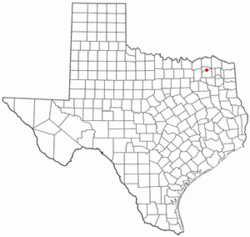Town in Texas, United States
Tira is a town in Hopkins County , Texas , United States. The population was 319 at the 2020 census .[ 4]
Geography
Tira is located in northern Hopkins County at 33°19′36″N 95°34′11″W / 33.32667°N 95.56972°W / 33.32667; -95.56972 [ 5] Texas State Highway 19 runs through the western part of the town, leading north 25 miles (40 km) to Paris and south 13 miles (21 km) to Sulphur Springs , the Hopkins county seat . Tira is 1 mile (1.6 km) east of the dam at the outlet of Jim Chapman Lake (formerly known as Cooper Lake) and is 9 miles (14 km) by road northeast of the South Sulphur Unit of Cooper Lake State Park .
According to the United States Census Bureau , the town has a total area of 1.4 square miles (3.7 km2 ), of which 0.02 square miles (0.06 km2 ), or 1.65%, are water.[ 6]
Demographics
As of the 2020 United States census , there were 319 people, 115 households, and 80 families residing in the town.
Education
Tira is served by the North Hopkins Independent School District .
References
^ "2019 U.S. Gazetteer Files" . United States Census Bureau. Retrieved August 7, 2020 .^ a b U.S. Geological Survey Geographic Names Information System: Tira, Texas ^ "U.S. Census website" . United States Census Bureau . Retrieved January 31, 2008 .^ a b "Explore Census Data" . data.census.gov . Retrieved May 22, 2022 .^ "US Gazetteer files: 2010, 2000, and 1990" . United States Census Bureau . February 12, 2011. Retrieved April 23, 2011 .^ "Geographic Identifiers: 2010 Census Summary File 1 (G001): Tira town, Texas" . American Factfinder . U.S. Census Bureau. Archived from the original on February 13, 2020. Retrieved March 15, 2018 .^ "Census of Population and Housing" . Census.gov. Retrieved June 4, 2015 .^ https://www.census.gov/ [not specific enough to verify ^ "About the Hispanic Population and its Origin" . www.census.gov . Retrieved May 18, 2022 .
^ Note: the US Census treats Hispanic/Latino as an ethnic category. This table excludes Latinos from the racial categories and assigns them to a separate category. Hispanics/Latinos can be of any race.[ 8] [ 9]


